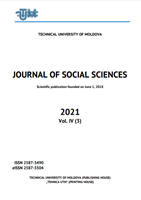LOCUINȚA MOLDOVENEASCĂ TRADIȚIONALĂ DIN SEC. XVIII-XX DIN PERSPECTIVA MATERIALELOR ȘI A SOLUȚIILOR CONSTRUCTIVE
THE TRADITIONAL MOLDOVAN DWELLING FROM THE SEC. XVIII-XX FROM THE PERSPECTIVE OF THE CONSTRUCTION MATERIALS AND SOLUTIONS USED
Author(s): Maria-Liliana MarianSubject(s): Cultural history, Architecture, Cultural Anthropology / Ethnology, Culture and social structure , Sociology of Art, History of Art
Published by: Universitatea Tehnică a Moldovei
Keywords: traditional housing; vernacular architecture; architectural solution; spatial structure; planimetry; volumetry;
Summary/Abstract: The article represents a research of the traditional houses from the Republic of Moldova specific to the period XVIII - XX centuries. Life, always conditioned by life, is a major program that, in the vernacular architecture of the Republic of Moldova, plays the role of the function of continuity. The main objectives of this article are to bring in heritage practice, beneficial information, both for the historical monument and for architects, specialists and the general public interested in the future of heritage objects, locally or nationally and how they influence the factors of decision involved. The slow transformations, recorded over the last two thousand years, in which we distinguish evidence of its evolution, are the result of slow transformations, both of techniques and instructional materials, as well as of the specific occupations and way of life sec. XVIII - XX. Starting from the semi-buried dwellings, the surface houses with a single level, constituted the architectural solutions with the widest spread on the whole territory of the country, until the middle of the century. XX. The architecture of traditional residential buildings - plan, size and appearance - were influenced by physical, social, historical, geographical conditions, the natural environment and the specifics of the household. The knowledge of the architecture of the traditional house contributes to the reconstruction of some aspects of the ancient culture, inextricably linked to the problem of the continuity of the local population on these lands. In the architecture of the traditional house, the normative thinking, common at the technical level of the society, is combined with the adaptation to the individual requirements. The lack of this information, especially important for those interested in the fate of the architectural heritage, can cause serious damage to the historical monument, namely the loss of structural elements, functional and stylistic elements, elements of composition, volume and structure. The ambiguities can distort the real value of the monuments and even the loss of the value of architectural heritage, so the historical monument becomes vulnerable in the future.
Journal: Journal of Social Sciences
- Issue Year: IV/2021
- Issue No: 3
- Page Range: 71-78
- Page Count: 8
- Language: Romanian

